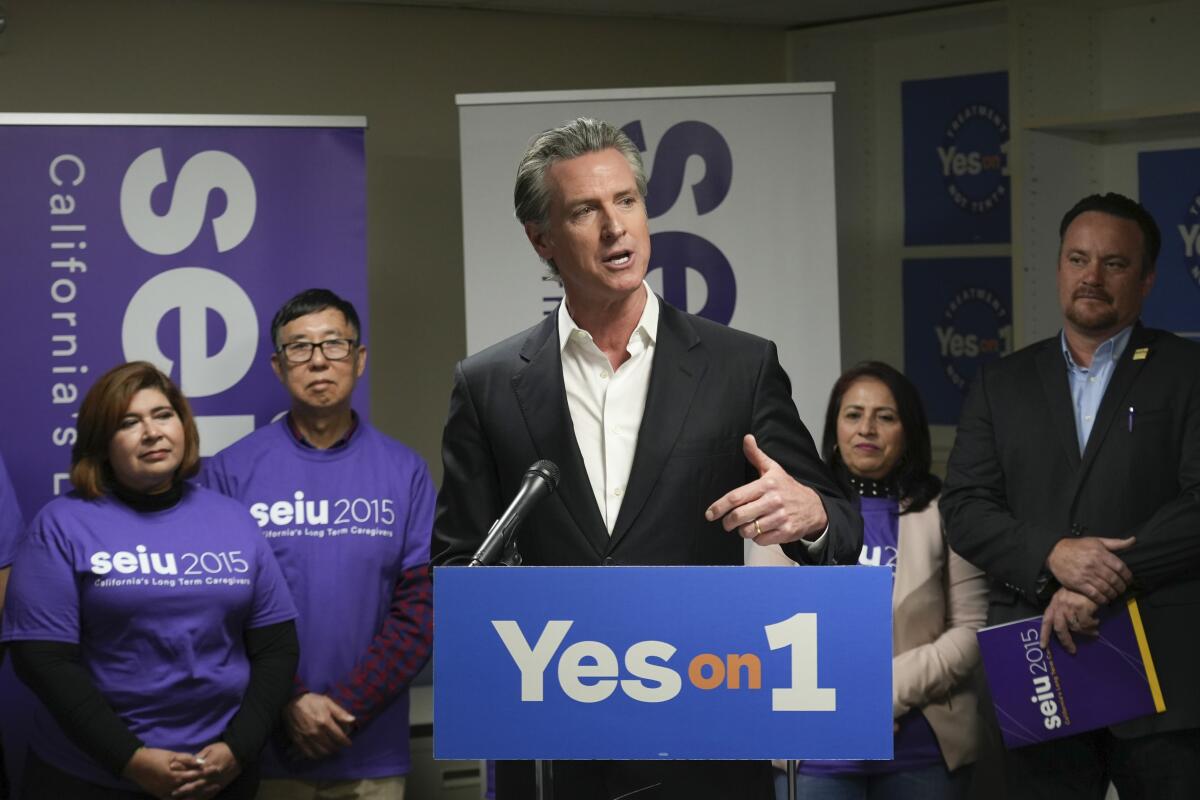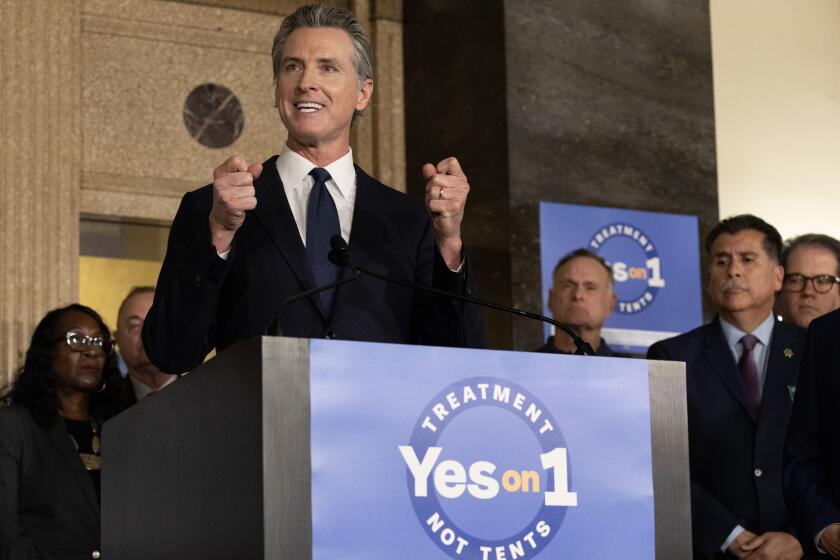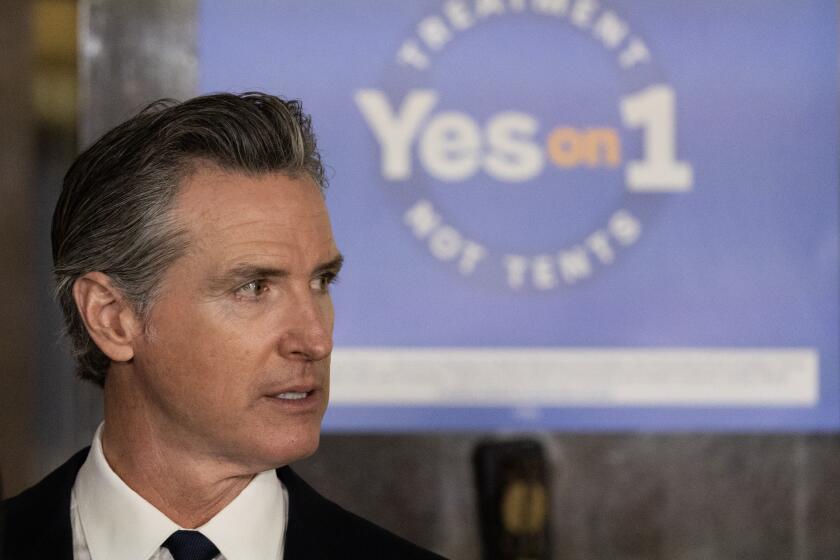Opposition concedes that Newsom likely to eke out a win on Proposition 1 in California

- Share via
Gov. Gavin Newsom brimmed with confidence about Proposition 1 in January as he sat in a Costa Mesa Motel 6 room that was converted into housing for homeless veterans.
“I think it’s going to win overwhelmingly,” the governor said in an interview with The Times. “Period. Full stop.”
Nearly two months later, Newsom’s cockiness appears misplaced.
Despite millions spent by his campaign, Newsom’s ballot proposal to increase care for drug addiction and fund more treatment beds has held only a narrow lead since the March 5 primary. Still too close to officially call more than a week after the election, preliminary tallies from the California secretary of state showed Proposition 1 ahead by less than a percentage point.
Even with that uncertainty, however, the meagerly funded opposition campaign conceded Tuesday that the measure was “almost certain” to pass.
“We almost took down the bear, but it looks like we will fall short,” the Californians Against Prop 1 campaign said in a statement.
Newsom’s campaign said it was “optimistic” about the outcome, but there are still ballots to be tallied. As of Friday morning, about half a million ballots remain uncounted statewide in an election expected to exceed 7.5 million votes in all, which could be one of the lowest turnouts percentagewise in state history.
The Associated Press, which member news organizations rely on to read results and call elections, said in a statement Tuesday that “the race could flip if ‘No’ does just 1.5 percentage points better among the outstanding votes.”
“AP has determined that is too much uncertainty to make a call at this time as results across the state are uneven.”
The results are so close that Newsom sent an email to supporters Thursday afternoon asking for volunteers to attend a training session this weekend to help the Prop. 1 campaign contact voters whose ballots were rejected for technical reasons and ask them to do the paperwork necessary to make their ballots valid.
“We need help reaching out to Democrats who have had their ballots rejected for things like forgetting to include a signature and get their ballots counted,” the email says.
California voters in the primary election decide the fate of Proposition 1, which Gov. Gavin Newsom has championed to address mental health and homelessness.
Pollsters say Proposition 1 — and most Democratic candidates — underperformed on election day because of lower-than-expected voter turnout that inflated the Republican share of the electorate. Election returns showed inland counties and parts of Southern California opposed the measure, while a majority of voters in Los Angeles and the Bay Area backed the plan.
“It was the angry versus the apathetic,” said Jim DeBoo, a consultant for Proposition 1. “Republicans are angry and they showed up.”
Though Newsom’s proposal received rare bipartisan support from both Central Valley Republicans and San Francisco Democrats in the state Legislature, that political harmony didn’t extend to voters. The measure was criticized by civil rights groups on the left who were concerned about the repercussions of funding secure mental health facilities and his GOP opponents on the right who scoffed at the estimated $14-billion price tag amid a massive state budget deficit.
Proposition 1 would approve a new $6.4-billion bond to support 10,000 treatment and housing beds and reconfigure a 20-year-old tax for mental health services to also fund services for drug addiction. The plan is essential to Newsom’s strategy to address California’s homelesness crisis, a persistent obstacle for the state and political vulnerability for the Democratic governor.
Under mounting pressure to clean up encampments and get people into treatment, the governor has adopted a series of policy positions that depart from the liberal model of voluntary treatment to a more moderate approach of compelling people with severe mental illness and substance disorders into care.
Newsom signed a law last year to expand conservatorship to allow courts to appoint someone to make decisions for people struggling with severe substance use disorders. Counties began implementing his CARE Court program, which gives families an opportunity to request that courts require treatment for a loved one, last year.
The lack of treatment beds and places to house an influx of patients has been the primary argument against Newsom’s strategy. In her state of the city address days after the election, San Francisco Mayor London Breed touted that the passage of Proposition 1 would provide “a real opportunity to add hundreds more” treatment beds.
“So when the state opens the pipeline for new beds, San Francisco is ready and first in line,” Breed said.
Civil rights organizations and advocates for the disabled community opposed the measure and raised alarm bells in 2023 over a last-minute change to Proposition 1 that allows counties to use the bond money for “locked facilities,” where patients cannot voluntarily leave.
American Civil Liberties Unions in California and League of Women Voters of California urged voters to reject the measure, arguing that community mental health services are more effective than institutionalization.
“I think the governor and mayors often just want the encampments to disappear by any means necessary,” said Katherine Wolf, a doctoral student in society and environment at UC Berkeley, who said she voted against Proposition 1.
Wolf said she believes that community programs that provide stability to some mentally ill Californians will lose funding if money shifts to involuntary treatment. Similar to the ACLU and League of Women Voters, she also opposes forcing people into care.
“For them to sneak it in at the last minute after promising all summer that the bond would only be used for community-based voluntary unlocked treatment, I think is really underhanded and I think they did it specifically to avoid objections from the groups and people who they knew would object,” Wolf said.
If Proposition 1 is approved by California voters, the bond to build more mental health facilities could cost $14 billion in debt and interest payments.
Newsom cast the measure as an opportunity to get more people off the streets and into treatment. The measure, he argued in an interview with The Times, addressed the most important issues to voters — crime, homelessness, substance abuse and mental health — and “90% of the boxes that unite the vast overwhelming majority of Californians.”
Early polls seemed to suggest Newsom was right. A survey conducted by the Public Policy Institute of California in November, for example, suggested that two-thirds of likely voters approved of Proposition 1, 30% opposed and a mere 2% remained undecided.
But despite the governor’s bullish stance publicly, behind the scenes his campaign predicted the final result would end up tighter than polls showed and sought to lower expectations in the months and weeks before the election.
Support dropped to 59% among likely voters in a second PPIC poll conducted in February.
By the end of the month, the measure teetered with only 50% support in a UC Berkeley Institute of Governmental Studies poll co-sponsored by the Los Angeles Times. More than one-third of voters were opposed and 16% remained undecided. A large majority of Republican voters who responded to the Berkeley poll opposed the measure, raising concerns about how Proposition 1 would fare in an election with higher GOP turnout.
In a memo sent days before the election, David Binder, a pollster hired by Newsom’s campaign, suggested the PPIC polling was optimistic given low turnout and underperformance among Democrats.
“It is likely that even as yes-on-Proposition 1 may have polled in the low 60s when first introduced in 2023 that the yes vote could end up in the low 50s, given the history of erosion in support for bond and tax measures and the specifics regarding low turnout and disproportionate Republican turnout that California is experiencing for the March 5th election,” Binder wrote.
Gov. Gavin Newsom crafted the measure to reform California’s mental health system, including a $6.4-billion bond for new facilities.
Mark DiCamillo, director of the IGS poll, said that despite the bipartisan support at the state Capitol, it should come as no surprise that Republican voters didn’t rally behind Proposition 1.
Republicans tend to oppose big-ticket ballot measures. Voters of all political affiliations who remain undecided in the final days before an election also often end up voting against a measure if their mind isn’t made up, he said. Complicated measures, such as Proposition 1, can easily confuse voters as well.
“One other difference that probably worked against it in this election was that the turnout was so low that you basically have three times as many older voters, who tend to be more conservative than younger voters,” DiCamillo said.
Newsom’s campaign said the governor intentionally chose to place the measure on the March ballot because they believed it could “withstand a more conservative electorate and still pass on election day” and due to the urgency of the issue.
Anthony York, a spokesperson for the campaign, said — and pollsters agreed — that the measure would have performed better if placed on the November ballot where Democratic turnout is projected to be higher.
But Democrats in Sacramento are also eyeing several other bond measures on housing, schools and climate to put before voters in November that could total tens of billions of dollars. With the state struggling to offset a budget deficit of at least $37.9 billion, bonds act as a method of sorts for government to take out loans paid back over time to fund big-ticket policies.
Voting on Proposition 1 in March instead of November was a strategic decision that allowed Newsom to avoid a crowded ballot in the fall, said Paul Mitchell, vice president of Political Data Inc.
“Voters do, if you accumulate ballot measures that have spending, start to kind of collectively go ‘no’ on them,” Mitchell said.
Times staff writer Hannah Wiley contributed to this report.
More to Read
Sign up for Essential California
The most important California stories and recommendations in your inbox every morning.
You may occasionally receive promotional content from the Los Angeles Times.
















